Know the profound symbolism of a 'sheepfold' in the Bible and its implications on your spiritual journey.

What Is a Sheepfold in the Bible
You've likely encountered the term 'sheepfold' while studying passages such as John 10 in the Bible, where Jesus refers to Himself as the 'good shepherd.'
But what does this term really denote in a biblical context? It's not merely a pen for sheep, but carries profound symbolic resonance. Unraveling its spiritual implications could lead to a deeper understanding of biblical teachings and parables.
How does this concept apply to your spiritual journey? Let's explore together.
Key Takeaways
- A sheepfold in the Bible signifies the church or body of believers, representing a sanctuary for them.
- Constructed as a pen for sheep, it embodies God's providence, protection, and love for believers.
- Sheepfold metaphors in biblical context, particularly in Jesus's parables, convey profound spiritual messages and truths.
- The symbol of sheepfold emphasizes the spiritual significance of following Christ's teachings and the promise of eternal life.
Understanding Biblical Symbolism
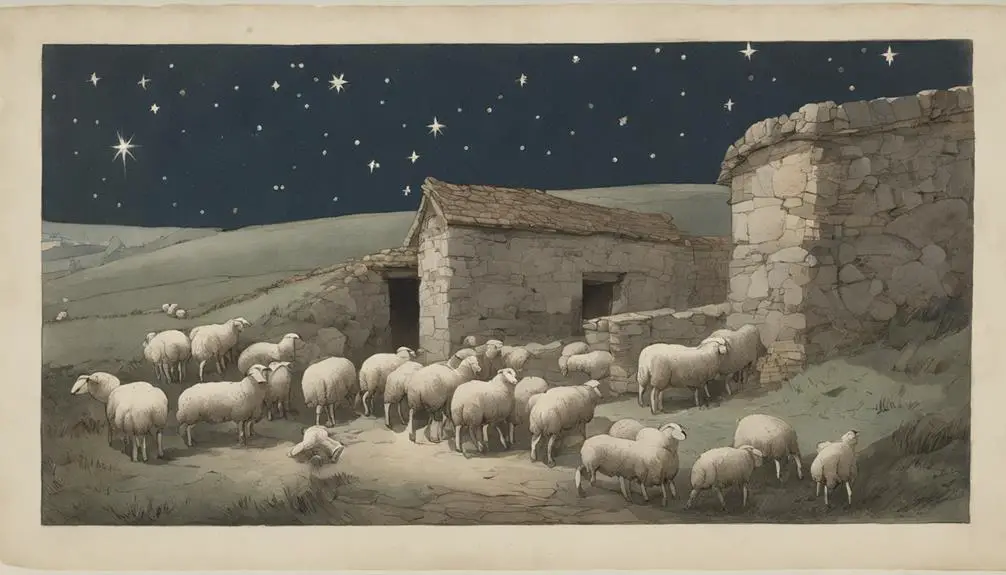
To truly grasp the depth of references to the sheepfold in the Bible, it's crucial for you to understand the inherent symbolism woven into the text. Biblical metaphors aren't merely poetic devices; they're profound tools used to convey spiritual truths. The sheepfold, for instance, is a rich symbol with multifaceted interpretations.
Firstly, the sheepfold is a metaphor for the church or the body of believers. It's a sanctuary, a safe place where the shepherd (Christ) protects his flock from external threats. This interpretation underscores the nurturing, protective role of Christ.
Simultaneously, the sheepfold also represents the confinement of the Law. Prior to Christ's advent, the faithful were 'enclosed' within the Law, adhering to rituals and sacrifices for atonement. Christ, the 'door of the sheepfold', represents freedom from this confinement, offering a path to salvation through faith.
Lastly, the sheepfold stands for heaven, the ultimate safe haven for believers. It's the final destination of the flock under the shepherd's guidance.
Definition of Sheepfold
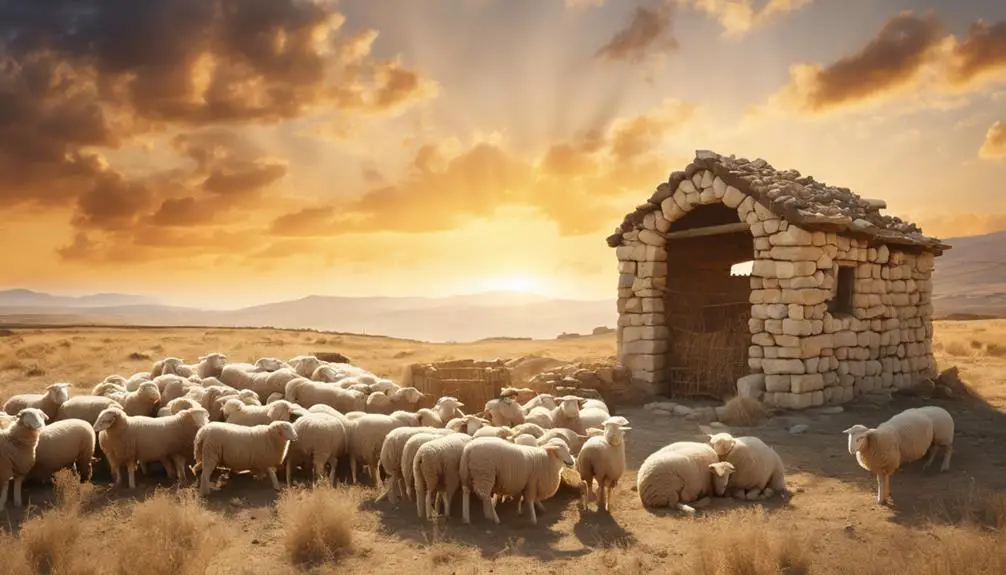
Diving into the definition, a sheepfold is essentially a pen or enclosure where shepherds keep their flock, providing a clear, physical representation of protection and community in biblical context. It's a simple structure, yet filled with profound symbolic meaning.
Let's delve into the particulars of sheepfold construction. Typically, it's a circular or square enclosure made from stones or wood. You might imagine a shepherd piling stones high enough to prevent sheep from escaping, while leaving a single opening for entrance and exit. This entryway is critical – it's where the shepherd stands guard, protecting his flock from predators.
Now, let's explore sheepfold usage. It's not merely a physical construct, but a metaphorical one. In the Bible, sheepfolds serve as metaphors for God's protection and guidance. They symbolize a place of security where the shepherd – representing God or a spiritual leader – guards and cares for his flock – representing believers or the faithful.
Sheepfold References in the Bible
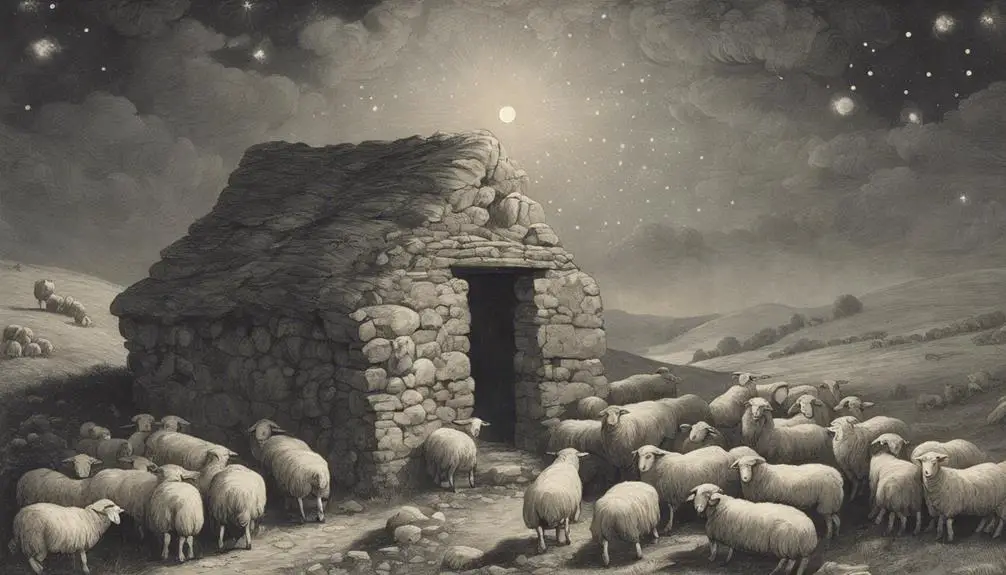
You'll find numerous references to sheepfolds scattered throughout the Bible, each one offering a deeper understanding of the metaphorical role they play in spiritual teachings and theological symbolism. To fully comprehend these Sheepfold Metaphors, it's essential to consider the Biblical Context in which they're used.
In Numbers 32:16, for example, the tribes of Reuben and Gad request lands suitable for their flocks, highlighting the practical, agricultural importance of sheepfolds. Yet, the Bible also uses sheepfolds to convey deeper, spiritual messages. Take the verse in John 10:1: 'Verily, verily, I say unto you, He that entereth not by the door into the sheepfold, but climbeth up some other way, the same is a thief and a robber.' Here, the sheepfold metaphorically represents the Kingdom of God, and the proper way to enter it.
Spiritual Significance of Sheepfolds
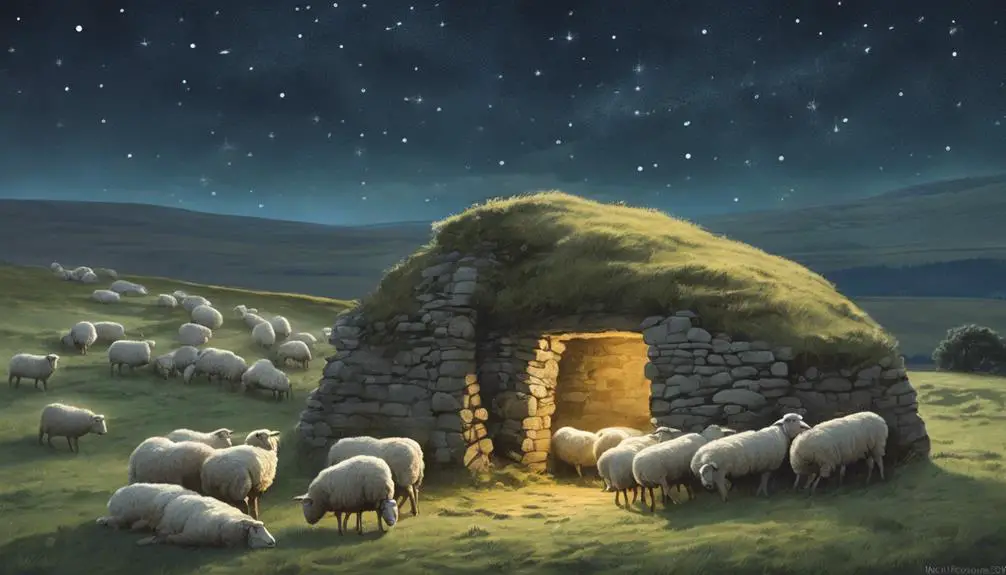
Unraveling the spiritual significance of sheepfolds in the Bible, we find a rich tapestry of metaphors that offer profound insights into our relationship with God and the path to salvation. The Sheepfold Metaphors are as intricate as they're enlightening. The sheepfold, a sanctuary for the flock, symbolizes the spiritual realm where God's followers find refuge and security. It's a reflection of God's providence and protection, a testament to His unwavering love and care.
The Pastoral Imagery, on the other hand, underscores the role of divine guidance. God is often depicted as the shepherd, leading His flock (us) to green pastures, symbolizing a life of peace and fulfillment. The shepherd's role in guarding the sheepfold emphasizes God's vigilance over His people, His readiness to shield us from adversities.
The sheepfold's gate offers yet another layer of spiritual significance. It represents Jesus, the sole path to the sheepfold, to salvation. No one comes to the Father except through Him (John 14:6). Therefore, the sheepfold isn't merely a safe haven; it's a spiritual destination accessible through faith in Jesus Christ.
Thus, every facet of the sheepfold metaphor carries deep spiritual meanings, helping us understand God's relationship with His people, His promises, and His salvation plan.
Sheepfold's Role in Jesus's Parables

In examining Jesus's parables, you'll notice how the concept of the sheepfold plays a significant role, often serving as a powerful metaphor for spiritual truths. The sheepfold, a safe enclosure for sheep, becomes a symbol for the Kingdom of God, where believers are safeguarded from spiritual dangers.
Consider the Parable of the Good Shepherd. Here, the sheepfold is used to represent the Church, and Jesus, the good shepherd, is the one who protects, guides, and sacrifices for his flock. This shepherd metaphor expresses the intimate relationship between Christ and believers.
Now, let's delve into the parable interpretations using a table for clarity:
Parable |
Interpretation |
|---|---|
The Good Shepherd |
The sheepfold is the Church, Jesus is the shepherd who protects and guides the believers. |
The Lost Sheep |
The sheepfold represents the Kingdom of God; the lost sheep symbolizes sinners, and the shepherd's joy upon finding the lost sheep signifies God's joy over a sinner's repentance. |
The Sheep and the Goats |
The sheepfold stands for eternal life; 'sheep' are those who serve others, reflecting Christ's teachings, while 'goats' ignore the needs of others. |
Through these interpretations, you'll deepen your understanding of the theological significance of the sheepfold in Jesus's parables.
Frequently Asked Questions
How Are Sheepfolds Used in Modern Religious Practices or Analogies?
In modern religious practices, you'll often find sheepfold symbolism. This pastoral imagery represents a safe haven or community.
The shepherd, often a metaphor for religious leadership, guides and protects the flock, symbolizing believers.
You'll see this analogy used in sermons, religious texts, and teachings to illustrate spiritual guidance and care.
It's a powerful tool for conveying faith-based concepts of community, leadership, and divine protection.
Are There Any Notable Differences Between the Use of Sheepfolds in the Old and New Testament?
Yes, you'll notice differences in sheepfold symbolism across the Old and New Testaments. In the Old Testament, sheepfolds often symbolize security and community. But in the New Testament, particularly in biblical parables like John 10, it's more about the relationship between the shepherd (Jesus) and his sheep (believers).
The sheepfold becomes a metaphor for the Church, emphasizing guidance, protection, and the intimate connection between Christ and his followers.
Can the Concept of a Sheepfold Be Found in Other Religious Texts Outside of the Bible?
Yes, you'll find sheepfold symbolism in non-Christian references too. Often, it represents a place of safety and community.
In Buddhism, the 'sheepfold' is metaphorical, symbolizing the community of believers. Similarly, in Zoroastrianism, it signifies protection provided by the faith.
It's intriguing to note how this symbol transcends religious boundaries, embodying similar notions of community, protection, and faith.
How Has the Interpretation of Sheepfolds Changed Throughout Different Periods in History?
As you delve into the evolving interpretations of sheepfold symbolism, you'll find that its meaning has shifted over time. Originally, it signified security and guidance provided by a shepherd, often linked to God's care for His followers.
However, over time, the symbolism expanded to embody community, spiritual growth, and even divine judgment. It's a complex, layered symbol that's evolved to reflect changing societal and religious perspectives.
What Cultural or Societal Factors Might Have Influenced the Biblical Authors' Use of Sheepfolds as a Metaphor?
You're exploring how cultural or societal factors might've influenced the biblical authors' use of sheepfolds as a metaphor.
Sheepfold symbolism in the Bible is greatly impacted by agricultural influence. As a largely agrarian society, their daily experiences with shepherding and sheepfolds likely shaped their metaphors, representing protection, guidance, and community.
These factors gave a rich, relatable depth to the biblical texts, allowing readers to understand divine concepts through familiar imagery.
Conclusion
In sum, you've learned that a sheepfold, in biblical terms, is a safe haven for sheep, symbolizing protection and community. It's frequently referenced in the Bible, highlighting spiritual security and unity.
The parables of Jesus further illuminate the sheepfold's significance, serving as metaphors for divine care. Thus, understanding the concept of a sheepfold offers deeper insights into biblical narratives, enriching your theological studies.

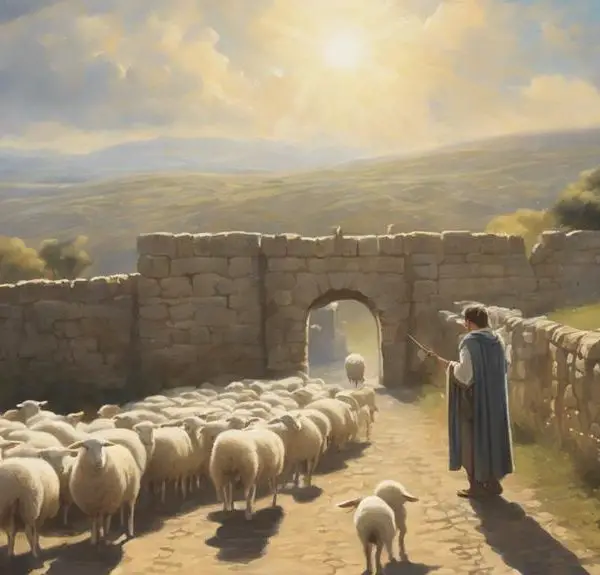
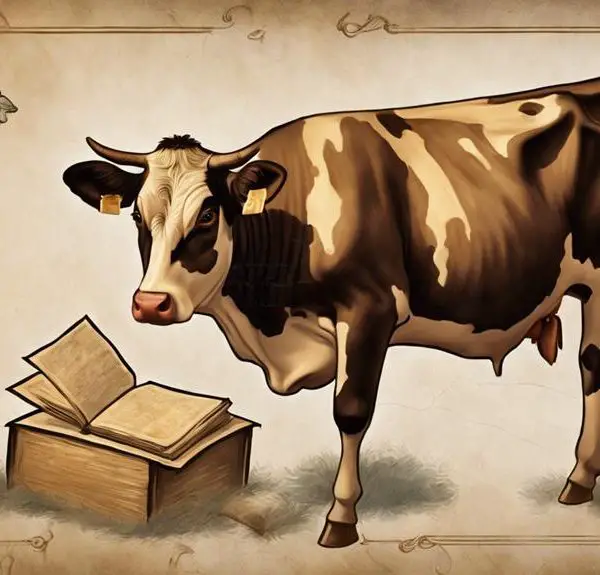
Sign up